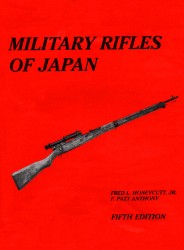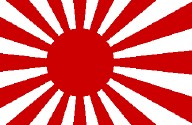 |
Arisaka Rifle Collector's Guide |  |
|
|
|
|
Firearms Technical Trivia, September 2000:
 |
Arisaka Rifle Collector's Guide |  |
In the late 19th Century, Imperial Japan joined other industrial nations in equipping its military forces a repeating bolt-action rifle that fired smokeless powder cartridges. This rifle became known as the Arisaka rifle, after the man in charge of selecting them, Lieutenant Colonel Nariakira Arisaka. From its adoption in the 30th year of the Meiji emperor (that's 1895 to those of you who don't speak Imperial Japanese dates) to the end of the World War Two (1945), the Arisaka served as Imperial Japan's main longarm in one form or another for fifty years.
Although many
were brought back by American GI's during and immediately
after World
War Two as souvenirs, they have never achieved the same degree of collectability
as the German K98 Mauser rifles. This is due in part to the relative
scarcity of ammunition chambered for these rifles, and the unearned reputation
for poor quality resulting from the very dangerous practice of firing standard
ammunition through training rifles. Times have changed, however,
and there is a growing interest in Arisaka rifles by historians, crufflers,
and people who wonder just what kind of rifle they found in their grandfather's
attic.
This is a primer for those wishing to know more about the Arisaka rifles and should be enough to help someone identify rifles of interest. For more detail, the collector may want to invest in a good reference book such as Fred Honeycutt's "Military Rifles of Japan."
GENERAL APPEARANCE: There are a few features common to all variants of the Arisaka rifles. These include a two-piece buttstock, plum or egg-shaped bolt handle, and a 16-petal chrysanthemum, or "mum," on the receiver ring.

Arisaka Receiver Ring Chrysanthemum |
In some cases, the mum may have been marred or ground off by Japanese soldiers in anticipation of the arm's capture by enemy forces or by General MacArthur's edict. (Both of these defacements serve the same purpose, to preserve the honor of |
The following
charts provide a rough guide toward interpreting these symbols:
1. The shiki (type)character and the characters for the Japanese numerals:
(Special thanks to Bryan Brown for permitting CRUFFLER.COM to use the above charts and data. Please visit Bryan's site at http://www.radix.net/~bbrown.)
Japanese Characters Used on Arisaka Rifles Character Meaning Type 1 2 3 4 5 6 7 8 9 10 2. Each Japanese rifle was marked with the symbol of either the arsenal of manufacture or the arsenal that supervised the manufacturing subcontractor. This mark can be found on the left side of the receiver at the end of the rifle serial number. Rifles manufactured by a commercial subcontractor bear the subcontractor's mark to the right of the supervising arsenal's mark.
Japanese Rifle Manufacturers Symbol Arsenal/Subcontractor Period of Operation Koishikawa Arsenal (Tokyo) 1870-1935 Kokura Arsenal 1935-1945 Nagoya Arsenal 1923-1945 Jinsen Arsenal (Korea) 1923-1945 Mukden Arsenal (Manchuria) 1931-1945 Toyo Kogyo 1939-1945 Tokyo Juki Kogyo 1940-1945 Tokyo Juki Kogyo 1940-1945 Howa Jyuko 1940-1945 Izawa Jyuko 1940-1945 3. All Japanese military rifles had serial numbers except extremely rare
prototypes, other pre-production guns, and occasional rifles assembled
very late in World War II. The serial number was stamped on the left
side of the receiver, followed by the arsenal symbol. Initially, rifles make
in Japanese arsenals were numbered consecutively within each Type
designation. In 1933 this scheme was replaced by a system in which
rifles were numbered in blocks, or series, of 99,999 each [actually
100,000, according to Honeycutt, running from serial numbers 0
through 99,999]. Each series was identified by a small Japanese
character (kana) placed within a circle to the left of the serial number.
Specific blocks of kana were assigned to each arsenal or manufacturer
to use for a specific rifle type.
Series Markings Series Number Series Mark Series Number Series Mark 1 24 2 25 3 26 4 27 5 28 6 29 7 30 8 31 9 32 10 33 11 34 12 35 20 37 21 40 22 45 23
ARISAKA
VARIANTS
Type 30 Rifle
and Carbine: These are easily identified
by the hook shaped safety on the back of the bolt. This and all models
until the Type 99 have a bore diameter of 6.5mm.
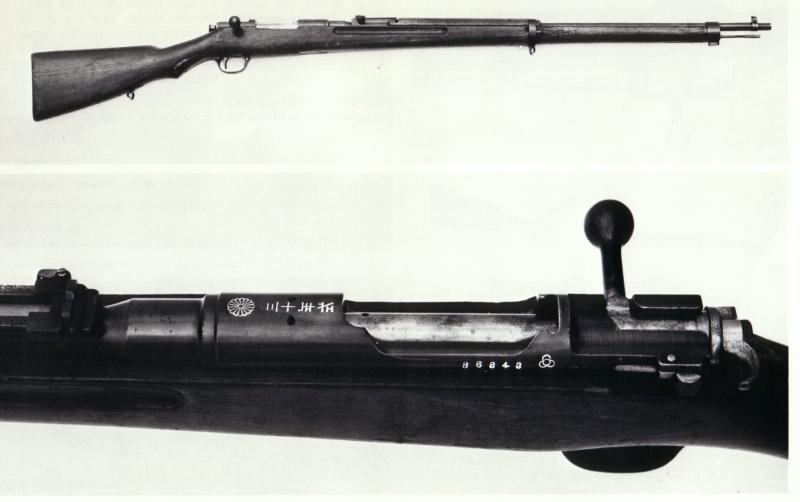
Arisaka Type 30 Image Credit: Honeycutt, Fred L. and F. Patt Anthoyn, Military Rifles of Japan, Julin Books, Palm Beach Gardens, Florida, 1996, Page 31 |
Type 35 Rifle:
These are rather scarce and can be identified by its small round safety.
Late in WWII, Japan created "substitute standard" rifles
using Type
35 barreled actions and "last ditch" parts made from inferior
materials.
These are referred to by collectors as the Model 02/45 rifle.
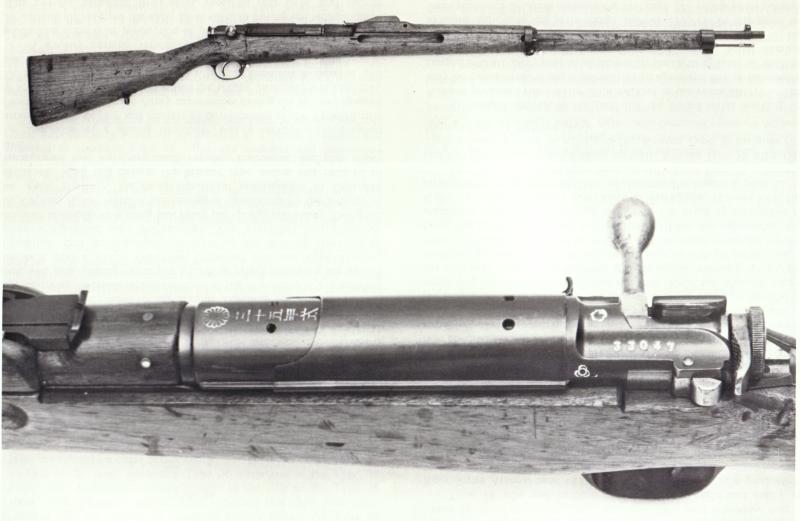
Arisaka Type 35 Image Credit: Honeycutt, Fred L. and F. Patt Anthoyn, Military Rifles of Japan, Julin Books, Palm Beach Gardens, Florida, 1996, Page 37 |
Type 38 Rifle and Carbine: These can be distinguished by both its very long and short lengths, elaborately machined safety knobs, and two gas vent holes over the chamber. Carbines have very short rear sights as opposed to the long ladder sights of the rifle. The Japanese rebarreled some rifles to an intermediate length, and designated them as "Cavalry rifles".
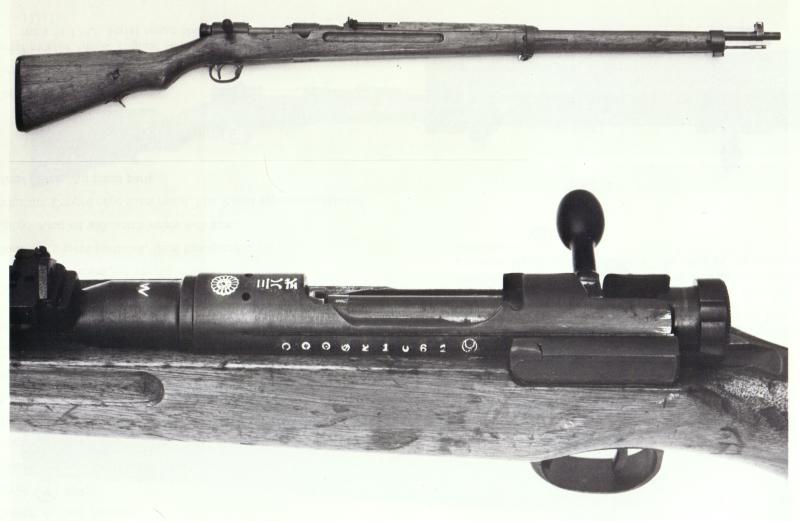
Arisaka Type 38 Image Credit: Honeycutt, Fred L. and F. Patt Anthoyn, Military Rifles of Japan, Julin Books, Palm Beach Gardens, Florida, 1996, Page 49 |
Type 44 Cavalry Carbine: These have a permanently mounted bayonet, side mounted sling swivels, and a trap built into the buttstock.
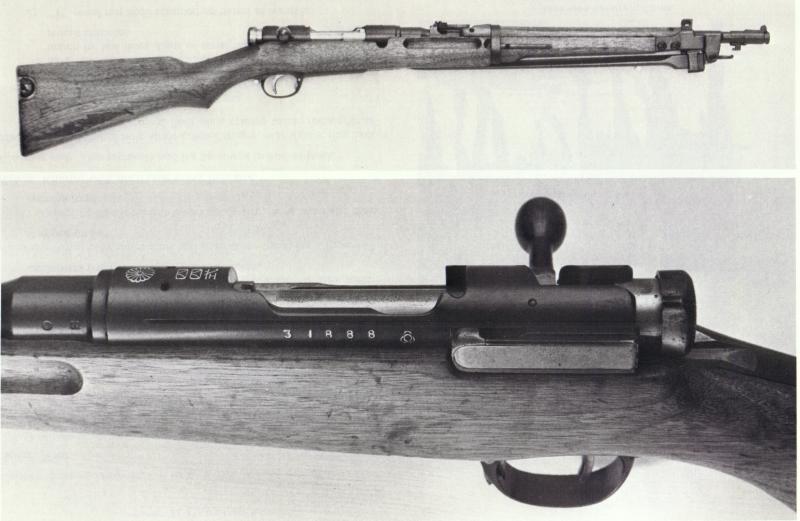
Arisaka Type 44 Image Credit: Honeycutt, Fred L. and F. Patt Anthoyn, Military Rifles of Japan, Julin Books, Palm Beach Gardens, Florida, 1996, Page 31 |
Type "I" Rifle: This Italian built rifle looks similar to the Type 38 rifle, except that it uses a Carcano action, has no vent holes, and lacks any markings except a serial number.
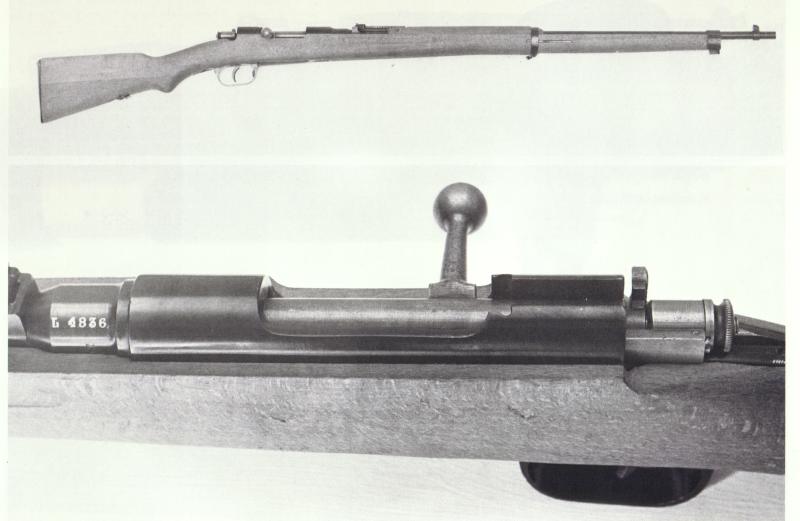
Arisaka Type I Image Credit: Honeycutt, Fred L. and F. Patt Anthoyn, Military Rifles of Japan, Julin Books, Palm Beach Gardens, Florida, 1996, Page 147 |
Type 99 Rifle: This is the WWII version of the Arisaka rifle and it differs from the earlier versions with a 7.7mm caliber bore, a single vent hole over the chamber, a front barrel band held on by screws or rivets, its intermediate length, and its rear aperture sight. As the war progressed and production became increasingly difficult, the rifles grew more crude in appearance as inferior materials were used and fit/finish standards were lowered significantly. These are often called "last ditch" models.
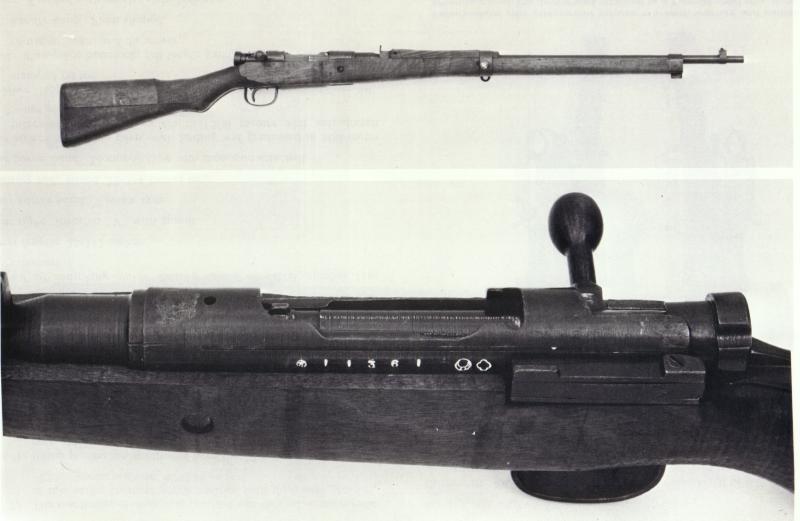
Arisaka Type 99 Image Credit: Honeycutt, Fred L. and F. Patt Anthoyn, Military Rifles of Japan, Julin Books, Palm Beach Gardens, Florida, 1996, Page 110 |
The following are relatively rare, but worthy of mention:
Paratroop Rifles: The Type 1, Type 2, and Type 100 paratroop rifles are all two-part takedown rifles that are similar to Type 99s in appearance.
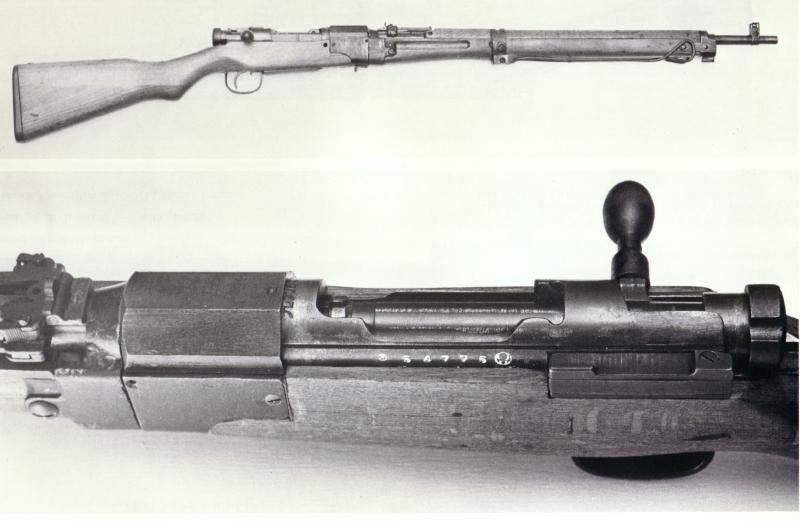
Arisaka Type 100 Paratroop Rifle Image Credit: Honeycutt, Fred L. and F. Patt Anthoyn, Military Rifles of Japan, Julin Books, Palm Beach Gardens, Florida, 1996, Page 31 |
Sniper Rifles: The Type 97 and Type 99 are basically standard Type 38 and 99 rifles that have been fitted with scope mounts and bent handles.
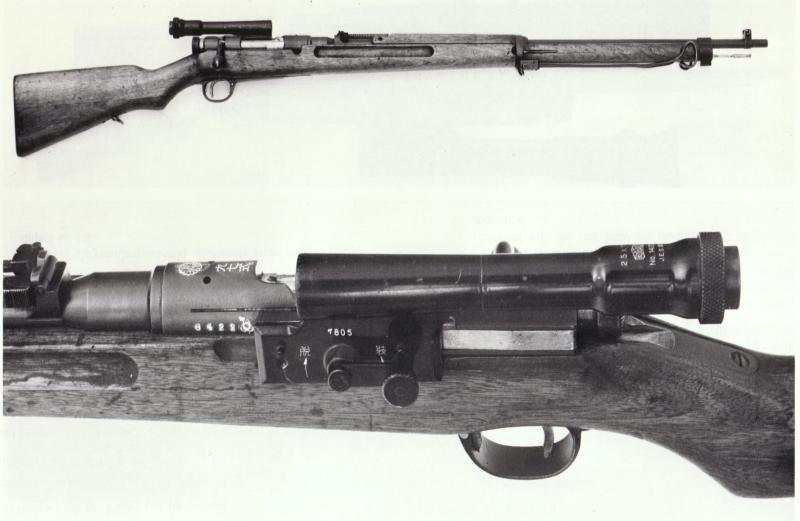
Arisaka Type 97 Sniper Rifle Image Credit: Honeycutt, Fred L. and F. Patt Anthoyn, Military Rifles of Japan, Julin Books, Palm Beach Gardens, Florida, 1996, Page 81 |
Training Rifles: These are Japanese rifles of all types that have been converted to smoothbore training rifles that can only be fired with blank ammunition. Other training rifles are no more than elaborate cap guns.

Arisaka Training Rifles Image Credit: Honeycutt, Fred L. and F. Patt Anthoyn, Military Rifles of Japan, Julin Books, Palm Beach Gardens, Florida, 1996, Page 173 |
Note: Data for this month's trivia page was gathered from:
Military Rifles of Japan, by Fred Honeycutt, Jr., Julin Books, 1996
Military
Rifles of Japan is available from IDSA Books. Click on the image
to order.
